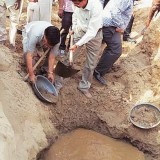An Indo-European Conference
The Indogermanische Gesellschaft organizes a conference every year. It must be one of the few international conferences where German is still spoken, along with English. I don’t know why I had never gone there, but this time (29-31 July 2013) I did. It was held in Leiden in the main building of the university administration, on the second floor. The painting on the back wall showed the liberation of the city by the Sea Beggars, breaking a one-year siege by the Spanish troops in the 16th century. That is where the successful rebellion against the Spanish king Philip II took off, ending with the independence of the Dutch Republic.
The topic was the Indo-European vowel system, a rather technical subject with which I will not bore my readers. Anyway, I didn’t go so much for the papers being read but to see the scholars face to face whom I knew from reading their works or discussing with them on-line. I came away with a very positive impression of people like Vaclav Blazek, Pjotr Gasiorowski and others.
What I really wanted to find out was the degree of penetration of the Out-of-India Theory (OIT), i.e. the idea that most European languages can be traced back to an origin in India. Most scholars had never even heard of it. They didn’t know better than that the homeland of the language family was somewhere in Russia and the Indo-Europeans from there invaded India: from an Indian viewpoint, the Aryan Invasion Theory (AIT). So, rather than believing and parroting that “nobody believes in the Aryan Invasion Theory anymore”, a smug and lazy position, Indians had better start the difficult work of informing and convincing the specialists.
Others knew it but had a negative opinion on it. Politically, they had vaguely heard of its association with “Hindutva” (Hindu nationalism), at least since its revival in the 1980s. Earlier Hindutva stalwarts, such as VD Savarkar who launched the political notion of Hindutva with his book of the same title in 1923, had been believers in the then-prevalent opinion, viz. the AIT. It is not necessary for a nationalist to believe that his ancestors were native: conquest can also form a good backdrop for the birth of a nation. I recognize the influence of Michael Witzel, indeed named as source by some of these scholars, in incorrectly identifying the OIT with Hindutva. Of course, nobody knew anything of the pernicious role which the AIT has been playing in India since the 1840s.
They also vaguely knew that “the Russian homeland (so, the AIT) has been proven”. One of them had heard of the work of Nicholas Kazanas, but had not studied it sufficiently to agree or disagree with its pro-OIT conclusions. As linguists, they thought that linguistics has proven it and refuted the OIT: just like the Hindutva dimwits who think that linguistics should be outlawed because it intrinsically supports the AIT. I can confirm that most people at the conference work within the Russian homeland framework, but that is different from having proven it.
They had also heard that genetics had provided the proof. As Michel Danino has shown, the extant genetic studies, while by no means final, rather support an Indian homeland. I particularly like that paper on cow genetics showing that the Ukrainian cows have a fair percentage of Indian cows among their ancestry. Migrant Aryan cowherds will have taken along their livestock, so this findings supports the reverse movement from what the AIT teaches. Some of the earlier studies of human genetics readily assumed the AIT and then used it in interpreting their findings, but that was no real proof either.
Finally, they had heard that archeology had furnished the evidence. I told them that many Indian archeologists reject the AIT precisely because, after 150 years of being the well-funded official theory, it has failed to come up with any proof on anything Aryan actually moving into India. But they took heart when I admitted that these archeologists have failed to come up with the converse evidence, viz. something Aryan moving into Central Asia, as their horizon totally stops at the Khyber Pass (the frontier between historical India and Afghanistan). They deny and claim to have refuted the AIT, but have not developed an OIT.
Anyway, these Indo-Europeanists swore by the work of Elena Kuzmina: The Origins of the Indo-Iranians (Brill, Leiden 2007), which assumes and works within an AIT framework, rather than proving it. But since it may contain elements of such much-prized proof, I availed of the 50% conference discount to buy a copy. I promise to offer a comment.
I also purchased Reconstructing Proto-Nostratic by Alan Bomhard, the elaboration of a macrofamily including Afro-Asiatic, Indo-European, Uralic, Altaic, Kartvelian, Elamo-Dravidian, Eskimo-Aleut, Sumerian and Etruscan. The inclusion of Afro-Asiatic is much debated, that is why I greatly appreciated Blazek’s presentation of a new isogloss between Indo-European and Afro-Asiatic. Bomhard locates its homeland in the Mesolithic (pre-agriculture, maybe 15000 BCE) fertile crescent, particularly Northern Mesopotamia. A subfamily containing Uralic, Altaic and Indo-European developed in what is now Northern Aghanistan and Tajikistan, whence Uralic and Indo-European went westward in a parallel movement, but in the latter case also southward to India.
I would say that India and Afghanistan are close enough, and that Bomhard, like everyone else, is conditioning by assuming the AIT beforehand. Well, no matter, I hope to meaningfully contribute to this ambitious debate. The idea of a genealogical tree of language families, ultimately uniting Nostratic with Sino-Caucasian and Amerind, and finally with the African and Australian languages, certainly offers an exciting perspective. Nostratic would also mean that the Aryans, along with the Dravidians, did invade India, though possibly much earlier than in the AIT. Unless the fertile Indus Valley itself can be shown to be the Nostratic homeland: a demographic concentration of people in South Asia at a time when much of Eurasia was not or hardly inhabitable, makes sense, as well as their northwards expansion after the Ice Age. In that case, the whole discussion starts again, ten thousand years earlier.
(4806)

